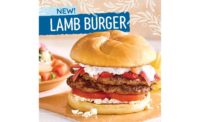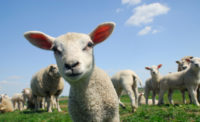Today, there are approximately 80,000 sheep ranches and farms in the United States that produce about 200 million pounds of lamb each year for the U.S. market. The vast majority of sheep operations are family owned and operated. Sheep are raised in every state in the country. Leading lamb producing states are California, Texas, Colorado, Wyoming and South Dakota.
Roughly 40% of American lamb is sold into foodservice and 60% into retail. Lamb imports from Australia and New Zealand represent approximately 50% of total lamb supplies in the U.S. Per capita consumption of lamb in the U.S. has remained fairly flat over the past 10 years at approximately one pound per person. The highest consumption of lamb is in the Northeast and California.
The American Lamb Board commissioned a study in 2011 of adult men and women to better understand how households view lamb. The results show that interest in lamb is increasing, yet consumers are not confident in how to buy and prepare it.
There are still many consumers that have never eaten lamb, noting that they have never had a chance to try it. Compared to ALB’s study in 2006, however, people are more likely to purchase lamb for household use today, and significantly more likely to ask their butcher for lamb from the U.S.
Lamb in retail
Roughly 60% of American lamb is sold into retail. While lamb accounts for only one percent of the total meat case, the proportion of meat cases that contain lamb year round and the variety of cuts being stocked has increased. The highest retail lamb sales are in the northeast followed by the southeast and California. The top-selling retail cuts are shoulder, leg and loin.
Lamb in foodservice
Roughly 40% of American lamb is sold into foodservice. The volume of lamb and variety of cuts sold into foodservice has been increasing during the last five years.
The American Lamb Board updated its annual menu study looking at lamb menu trends in fine-dining and chains/independent restaurants across the country. The study, conducted by Datassential MenuTrends™ reported that lamb entrees remain an essential item at fine-dining restaurants, where it can be found on more than two out of three of these restaurants menus.
Lamb is often menued with traditional flavorings such as garlic, rosemary, mint, mustard, thyme and red wine, according to a 2012 report. While it is often served with potatoes, it often appears with Mediterranean sides such as polenta, risotto, olives, eggplant and artichokes. Lamb pasta and noodle dishes have grown steadily on menus in recent years as well.
Lamp appetizers are growing in popularity. While lamb is most often served as an entrée at fine-dining restaurants, appetizer menus are showing some unique ways to add lamb to the menu — from riblets to sliders to spring rolls.
Rack of lamb is the most popular cut found on fine-dining menus, followed by miscellaneous lamb chops, shanks and loin. The most popular way of preparing lamb at fine-dining restaurants is grilling, followed by braising and roasting. From herbs to pistachios to bread crumbs, encrusted lamb appears as a popular preparation method to add flavor as well.
Among fine-dining operators offering lamb on their menus, more than 22 percent specify it as domestic, while imported lamb sources are mentioned by less than 10 percent of restaurants. Colorado is the most commonly specified lamb on menus, but specific local ranches are being noted on more and more menus.
While lamb menu penetration is lower on quick-service, mid-scale and casual-dining chain and independent menus, lamb’s appearance on these menus has increased during the last four years. Examples of lamb use include lamb burgers, lamb samosas, lamb flat bread, barbecued lamb ribs, gyros, lamb kebobs and stews.




Report Abusive Comment